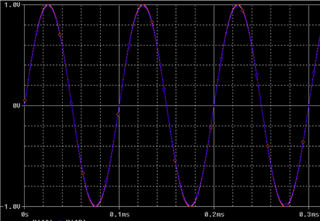Other Parts Discussed in Thread: SN74LVC1G3157, SN74LVC2G66, TMUX1248, TMUX1119, OPA1678
Hi - I have simulated the reference design for the LVC2G266 in PSPICE, the only change to the schematic being to tie the control pin permanently high.
The image below is the resulting waveform seen either side of the switch - the result shows the output directly on top of the input which is as expected from a closed switch.
The datasheet gives the recommended voltage range for the I/O pins (Vi/o) as 0V to VCC. The simulation shows the device operating happily with an input of +1 V to -1V. Is the simulation correct? Would the negative voltages cause damage? Or am I misinterpretting the datasheet?
The device I actually want to use is the 74LVC1G157 which has similar datasheet characteristics, but doesn't seem to have a PSpice model. I want to use the part as a switch for an analogue signal that will be biased around 0V (as per the simulation), but will be limited to very low signal amplitudes (less than +1mV to -1mV swing). Is this simulation also applicable to the 74LVC1G157?







